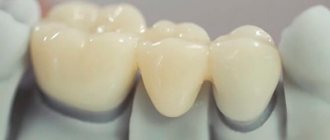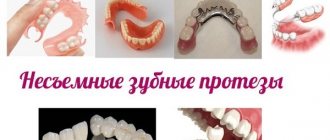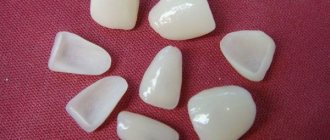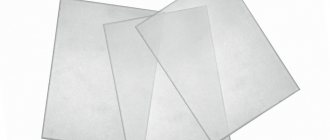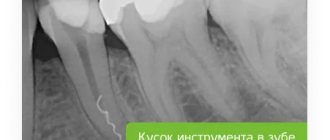In modern dental prosthetics, different types of orthopedic structures can be used, including removable and fixed bridges. We will talk in detail about what it is, in what cases the use of bridges in restoration is indicated, what types of them exist - we will talk in detail in this article. The material will also tell you about the prices for dental bridges: taking into account what factors they are formed and whether it is possible to save on the prosthetic service without compromising the quality of its provision.
Dental bridges: general information
In dentistry, a dental bridge is a special type of orthopedic structure, which may consist of one or more artificial dental units connected to each other. Bridges, the price of which depends on their type, can be used to restore a different number of dental units, and the base of the prosthesis can be attached both to abutment teeth and fixed to previously implanted implants.
The use of bridges in the prosthetic procedure allows you to effectively solve the following problems:
- Completely restore dental units lost for various reasons.
- Maintain correct diction and full taste sensations for the patient when eating and drinking.
- Restore the aesthetics of your smile.
The process of getting used to bridges occurs quite quickly and with a minimum of discomfort for patients. You can find out details about the bridge prosthetics service and the prices for it at any time convenient for you - to do this, just dial the contact phone number of our dentistry in Moscow - Vanstom!
Bridge prosthesis
from 19800 rub. More about prices
We have been working since 1994
we are one of the first to open private dentistry in Moscow
Best materials
only new and modern equipment for dental treatment
Free
consultation with a dentist
Payment options
- cash
- plastic cards
- cashless payments
Doctors' experience
- with great experience
- graduated
- conference participants
How to put a bridge on teeth -
Installing a bridge on teeth is carried out as follows... The teeth located on the sides of the missing one will act as support for the bridge. If only 1 tooth is missing, crowns are usually taken on one tooth on each side of the missing one. If 2 teeth are missing in a row, then a total of at least 3 teeth are taken under the bridge supports (one on one side of the dentition defect, and two on the other).
How to put a bridge on teeth: diagram and photo
Installing a bridge requires grinding down the supporting teeth for crowns, and here it must be taken into account that for different types of artificial crowns the thickness of the preparation will differ. For metal-ceramics, teeth are ground from the chewing surface by 2.0-2.5 mm, from the lateral surfaces by 1.5 mm (Fig. 4). For crowns made of metal-free ceramics - only 1.5 and 1.0 mm, respectively (Fig. 5). Moreover, the more tooth tissue is preserved under the artificial crown, the longer its service life will be.
Schemes for preparing teeth for crowns –
Moreover, please note that in the gingival zone, the tooth crown is ground in such a way that a so-called “ledge” (i.e., a step, Fig. 6) is formed along the entire perimeter of the tooth stump. The service life of the crown will largely depend on the quality of the ledge formation, because poor/inaccurate fit of the crown to the neck of the tooth in the area of the ledge - leads to the gradual entry of bacteria under the crown and the beginning of decay of the tooth tissue. And this happens very often.
Preparation of supporting teeth for prosthetics –
In many cases, teeth under artificial crowns are subject to depulpation, i.e. the nerve will need to be removed. This is due to the fact that deep in the tooth there is a neurovascular bundle (pulp), and the more tissue is ground off when preparing a tooth for a crown, the higher the risk of nerve injury. Accordingly, because Under metal-ceramics, more tooth tissue is ground off - here it is possible to leave mainly only large molars alive (they have a greater thickness of hard tissue around the nerve).
But for ceramic crowns, almost 2 times less tooth tissue is ground off, and in this case, almost all the teeth can be left alive. Keeping your teeth alive is very important because... after removal of the neurovascular bundle, the tooth stops receiving moisture and nutrition from the inside, which leads to an increase in the fragility of the hard tissues of the tooth and reduces its service life. The cost of removing nerves and filling root canals will depend on the number of root canals in the supporting teeth, and on average will be (for 1 tooth) –
- tooth with 1 root canal – from 2500 rubles,
- tooth with 2 channels – from 3800 rubles,
- tooth with 3 channels – from 5,000 rubles.
Dental bridge: before and after photos
Important: if the adjacent teeth from the missing one do not have fillings and are alive, then prosthetics with a bridge and grinding down the adjacent teeth for crowns is actually a very bad idea. The price of a dental bridge of 3 units made of ceramics or good metal-ceramics (taking into account the cost of preparing teeth for prosthetics) is almost always higher - when compared with the cost of installing 1 economy-class implant.
A dental bridge should be done only if the adjacent teeth from the missing one have large fillings (taking up more than 1/2 of the tooth crown in volume), and also if the nerves have been removed from them. Remember that the service life of the best crowns will be, at best, no more than 10-15 years, and what will happen to the supporting teeth after this time, and whether they can be re-used with prosthetics is still a big question. Your own living teeth (as opposed to artificial crowns) can last you much longer.
Types of bridges
Prices for dental bridges can vary, and the main factor influencing the cost of prosthetics is the type of orthopedic structure that will be decided to be used in the procedure for restoring lost teeth. Therefore, it is worth getting acquainted with the main types of dental bridges before going to dentistry and studying their features, pros and cons. In modern dentistry, dental bridges can be made from different materials: metal, ceramics, and various polymers.
The material used to make the bridge will determine its functional and aesthetic characteristics, as well as the price of the bridge and its installation. Which prosthesis to choose? The choice of a bridge will depend both on the individual characteristics of a particular case and on the patient’s preferences, however, it is important to understand that only an experienced dentist can correctly select a bridge for a patient. Below we consider the main types of existing bridges and their characteristics.
Why does the bridge have this name?
What it is becomes clear if you clarify the meaning of the word “adhesion”. Adhesion (from the Latin adhaesio) is the ability of dissimilar materials to stick to each other. Thus, a bridge of this type is not attached to ground support units using crowns, but is “glued” to the teeth adjacent to the defect. It is called Maryland, or even Manhattan, because of the shape of the structure - an artificial tooth-base and “wing” plates extending from it on both sides.
PROSTHETICS WITH 6 OSSTEM IMPLANTS FROM RUB 220,000.
Complex implantation Osstem (South Korea) with delayed loading after 4-6 months.
Call now or request a call
Its difference from a conventional bridge is that it is fixed by means of these thin plates, which are located on the side of the tongue and are attached to the inside of two supporting elements. This attachment is almost invisible in the oral cavity.
Read more about classic dental bridges in the material “Review of bridge models: for what cases are they suitable, how much do they cost and how long will they last?”
Metal bridges
The key advantages of bridges made of metal alloys include maximum strength of the bridge, as well as low price. But in modern dentistry, metal bridges are used extremely rarely, since they have a number of significant disadvantages:
- Low aesthetics compared to bridges made of ceramics, acrylic and other materials.
- Significant weight of the bridge, which increases the load on the supporting dental units and soft tissues of the oral cavity.
- High risks of allergic reactions and galvanic syndrome.
A metal bridge is not applicable in the restoration of the anterior dentition: it will be too visible against the background of natural teeth.
Recommendations after installation
Artificial structures also need to be properly maintained. If hygiene rules are not followed, this will significantly reduce the life of the product, and the patient will again have to use the services of an orthopedist.
Dentists recommend the following measures when performing dental prosthetics with bridges:
- Daily cleaning in the morning and evening. You must use a brush and paste. After each meal, you need to rinse your mouth with clean water or mouthwash, and use floss (dental floss).
- Hard-to-reach areas and interdental spaces are cleaned using sweeping movements without pressing on the crowns.
- It is important to exclude hard nuts, seeds and other foods from your diet that can cause chips and cracks.
- During the first time after installation, you should not drink coffee and tea, red wine, or freshly squeezed juice.
- You should visit the dental clinic for preventive examinations at least once every six months and undergo professional cleaning.
All structures have a certain service life. It depends on the material used and manufacturing technique. This period varies from 5 to 15 years. Sooner or later the product will have to be replaced, otherwise it may simply break and fall out.
The device is dismantled prematurely with the following problems:
- loosening;
- broken crowns;
- chipping of small fragments, appearance of microcracks;
- inflammation of soft tissues, bleeding gums;
- washing out the cement composition on which the system rests.
Only a specialist can safely remove the prosthesis; you cannot do it yourself at home. If you follow all the rules listed above, your smile will remain dazzling for a long time, and replacement will not be needed soon.
Metal-ceramic bridges
A metal-ceramic bridge is considered the best option in terms of price-quality ratio. A bridge of this type is not inferior to metal products in terms of strength, durability and reliability, but will look more aesthetically pleasing, since its frame is covered with a layer of dental porcelain in a shade identical to natural tooth enamel. Metal-ceramic dental bridges are hypoallergenic; the adaptation process to them is much faster and causes almost no discomfort to the patient.
Among the significant disadvantages of a metal-ceramic bridge, it is worth noting the only key point: the prosthesis does not have natural translucency and therefore its frame can be visible through the ceramic layer. The price of a metal-ceramic bridge prosthesis is higher than the cost of products made of metal alloys.
The advantages of this type of prosthetics
Among the advantages, the following qualities of such structures have been identified:
- the adjacent supporting units, as well as the gums, are not injured when fixing the prosthesis. And this is perhaps the main advantage of adhesive prosthetics, which attracts many patients,
- fast recovery,
- there is no need for anesthesia when preparing for prosthetics,
- low cost of treatment,
- the ability to replace the prosthesis without damaging the supporting teeth,
- are non-removable, which distinguishes them favorably from immediate prostheses (“butterflies”), used as temporary structures,
- high aesthetics: when using ceramics or composite materials, crowns look natural, and the shade of the prosthesis can be precisely selected.
You can evaluate the advantages of various types of fixed prosthetics in the article on our website “Comparison of fixed prostheses.”
Zirconium dioxide bridges
Zirconium dioxide is a special material that is in demand in modern dentistry in the manufacture of various kinds of orthopedic products, including removable and fixed bridges. The price of a zirconium bridge will be quite high, but the inflated cost of the prosthesis is fully justified by the following performance characteristics:
- High levels of biocompatibility with natural tissues of the human body, hypoallergenicity.
- A zirconium bridge is lightweight, which eliminates excessive stress on the jaw.
- Increased strength and long useful life of a zirconium bridge.
Zirconium bridges look aesthetically pleasing and therefore can be used to restore lost teeth in the smile area.
When can you build a bridge?
It is important to correctly draw up a prosthetic plan and ensure the stability of the supporting teeth.
Movable units or those affected by caries cannot serve as the basis for the structure. An upper or lower bridge is installed on natural teeth. When asked by patients: “Is it possible to install a bridge structure on an implant on one side and a tooth on the other?” there can only be a negative answer. A real, living dental unit has some mobility, and the implant is fixed rigidly, motionless, as in the following photo:
The bridge will loosen the implanted artificial root and place an inadequate load on the natural tooth. Plus, the service life of the implant is long, often lifelong. Real units are more vulnerable. The supports can be either two real teeth or a pair of implants.
If a tooth has been removed, but the crowns and roots of the units located next to the gap are strong enough, then a bridge is one of the rational and inexpensive methods of prosthetics.
Ceramic bridges
In terms of aesthetics, ceramic bridges made of ceramics are superior to all other subtypes of dental bridges. Their design does not have a metal base, which could be clearly visible when exposed to bright light. Visually, ceramics cannot be distinguished from natural teeth.
Another significant advantage of ceramic bridges is minimal trauma to the teeth and soft tissues of the oral cavity during bridge installation. In terms of price, ceramic bridges are more expensive than bridges made of other materials, but the costs are fully recouped by the impeccable results of prosthetics in terms of aesthetics and durability.
Omerelli Emir Romanovich
Specialization: maxillofacial surgeon, implantologist Work experience: more than 9 years Place of work: Works at SIMPLADENT Medical Center on Dmitrovskaya and SIMPLADENT Clinic on Proletarskaya First category doctor.
Candidate of Medical Sciences. He was one of the first to use the method of single-phase dental implantation with instant loading in Russia. He is a member of the Open Dental Community (ODC), where he took part in the development of the ROOTT implant system.
Every day he performs operations on classical dental implantation and implantation with immediate loading for complete and partial edentia.
Plastic bridges
The price of a plastic bridge will be as low as possible, but the savings from its installation will be questionable: an acrylic bridge is neither strong nor durable. Its aesthetics are also low: it is quite easy to notice plastic teeth against the background of natural teeth.
Plastic bridges can be considered as a temporary option for prosthetics, and for permanent installation, you can subsequently choose another, more durable and reliable type of bridge.
Another type of bridge will be an adhesive bridge. The peculiarity of this type of bridge is that it is created directly in the patient’s oral cavity. The artificial tooth unit is built up on a fiberglass pin element and then attached to its “neighbors” along the row. Prosthetics using adhesive bridge processes is considered the most gentle procedure, since it does not require grinding of teeth.
If you decide to engage in dental restoration and are interested in the service of installing a bridge, its price - call and make an appointment at our dental clinic in Moscow - Vanstom. We are ready to offer each of our patients high-quality prosthetic services at affordable prices. We provide a guarantee for all types of bridges!
Indications and contraindications for installation
The procedure is indicated when a person is missing one molar or 1-4 front incisors and canines. In this case, intact teeth should remain on the sides, which will subsequently act as supporting elements and withstand the greatest pressure when chewing food. Also, this cannot be avoided when the previous design has become unusable.
Despite all the advantages of orthopedic intervention, there is a list of cases when it is contraindicated:
- absence of more than 4 crowns;
- bruxism (involuntary grinding of the jaws, which is most often observed at night);
- malocclusion (before prosthetics you will have to undergo long-term orthodontic treatment);
- acute form of periodontitis or severe periodontal disease;
- pathological abrasion of the enamel layer;
- diseases of the skeletal system (for example, osteomyelitis);
- inflammatory processes in the oral cavity;
- poor hygiene preventing installation.
In addition, this also includes general contraindications to surgical intervention. These are problems with blood clotting, allergic reactions to drug components, manufacturing materials, chronic diseases during exacerbation, taking medications that prevent blood clots, and mental disorders.
Bridge prosthesis: price
| — Restoration of the dentition using 1 unit of plastic crown. | 4000 rub. |
| — Restoration of a tooth crown using 1 unit of a solid crown coated with titanium | 5500 rub. |
| — Restoration of dentition using 1 unit of metal-ceramic crown | 8000 rub. |
| — Restoration of the dentition using 1 unit of metal-ceramic crown with a ledge | 10,000 rub. |
| — Restoration of the dentition using 1 unit of metal-ceramic crown with effect masses | 13000 rub. |
| — Restoration of the dentition using 1 unit of metal-ceramic crown with cervical mass | 13700 rub. |
| — Restoration of the dentition using 1 unit of metal-ceramic crown with cervical mass | 12000 rub. |
| — Restoration of dentition using 1 unit of metal-ceramic crown on precious metals | from 14500 rub. |
| — Dental restoration using 1 unit of ceramic crown on cerconium oxide (CEREC) | 20,000 rub. |
| — Dental restoration using 1 unit of crown per implant (CEREC) | 24500 rub. |
| — Restoration of the dentition using 1 unit of ceramic crown (Empress) | 18,000 rub. |
| — Restoration of the dentition using 1 unit of ceramic crown per implant (Empress) | 20,000 rub. |
| — Taking a single-layer impression and casting a non-separable model | 300 rub. |
| — Taking a two-layer impression and casting a collapsible model | 800 rub. |
| — Fixation of the crown with glass ionomer cement, composite | 600 rub. |
| — Fixation of the crown with double-curing cement | 800 rub. |
View price list
Steps to install an adhesive bridge
The installation of a Maryland bridge can be carried out in one or several visits to a specialist. This is largely influenced by the condition of the supporting teeth on which the prosthesis will be fixed, as well as the features of the chosen design. The stages of manufacturing the structure will depend on the chosen technique: it is possible to manufacture the prosthesis both in the laboratory and clinically, that is, directly in the patient’s mouth.
The following main stages of adhesive-bridge prosthetics can be distinguished:
- treatment of supporting teeth: if necessary, cleaning, caries treatment, grinding or surface treatment of enamel is carried out. Minimal sanding is necessary to ensure adhesion of surfaces,
- taking impressions: used when the bridge is made in the laboratory, and not directly in the mouth during the appointment,
- production of the prosthesis: with the indirect method, it is carried out in the laboratory, especially when made from materials such as plastic and ceramics, the processing of which is impossible in the oral cavity. With the direct method, that is, directly in the oral cavity, the prosthesis is made by a doctor in one visit. The optimal material for the direct method is a light-curing composite,
- fixation of dentures: the structure is fixed using special dental cement.
Materials used in metal ceramics
In metal-ceramics, a metal frame is used as a base, which solved the problems of excessive fragility of ceramics. Ceramic is applied layer by layer to the outer surface of the metal and held firmly in place by sintering. As a result, a metal-ceramic crown is reliable, durable and very beautiful. Plus, it looks like a real healthy tooth.
To effectively protect teeth from destruction under crowns, teeth are treated with a protective paste that releases fluoride into the tooth tissue. Modern dental cements are used to fix metal-ceramics, which makes it possible to achieve the strongest fixation. A high-quality metal-ceramic structure lasts for decades. The average service life of cermets on base alloys is 10-12 years. On gold-platinum alloy 15 years or more.
The use of inlays for attaching prostheses
To fix bridges, it is allowed to use special inlays made of ceramic or metal material. In this case, there is no need for total grinding of the supporting crowns: it is enough to make a small ledge on the chewing side of the dental unit.
The installation of such products is recommended only to reproduce 1 lost unit in the presence of healthy nearby crowns. In addition, due to the insufficient stability of structures on inlays, sometimes it is necessary to fix the crown at one edge.
A number of significant disadvantages of adhesive bridges
Despite the large list of advantages, the Maryland Bridge also has disadvantages. The disadvantages are as follows:
- relative fragility of the prosthesis: it is for this reason that dentures are not installed in the chewing zone and do not replace more than two units with them. This design is not designed for high loads, it can come off, so it is recommended to handle the prosthesis as carefully as possible, try not to bite or chew food at the site where the prosthesis is installed,
- fragility of the structure: it is used for temporary prosthetics, since the service life of even the most durable structures is no more than 3–4 years,
- incomplete restoration of a missing tooth: the prosthesis serves rather to eliminate a cosmetic defect, but does not restore functionality, that is, it cannot be fully chewed,
- complication of hygiene in the places where the prosthesis is attached and in the interdental spaces, which increases the risk of developing caries.
Despite the restoration of the row under the adhesive prosthesis, bone atrophy continues to progress at the site of the lost tooth. The lack of chewing load reduces tissue nutrition and accelerates bone loss, which over time leads to various negative consequences.
Ceramic lining in metal ceramics
The quality of a metal-ceramic prosthesis depends on many factors. Color accuracy is determined mainly by the quality of the ceramic mass. Imported ceramics convey color more accurately than domestic ones; in addition, they are more stable during processing and use - they do not change color when fired, and do not crack.
If you have a problem similar to that described in this article, be sure to contact our specialists. Don't diagnose yourself!
Why you should call us now:
- We will answer all your questions in 3 minutes
- Free consultation
- The average work experience of doctors is 12 years
- Convenient location of clinics
Single contact phone number: +7
Make an appointment
Applying porcelain mass to a metal frame is a long and painstaking job, since it is applied in layers and after each application the mass is fired in a special vacuum oven. Firing metal ceramics is a very important task. If the temperature or barometric modes are chosen incorrectly, the ceramics will crack and all the work will have to be done again. It is thanks to the layered application of porcelain that metal-ceramic teeth accurately convey the color and transparency of natural teeth. In addition, porcelain is intertwined with the tissues of the oral cavity and is hygienic.
Recently, ceramics have appeared in world dental practice, having a rigidity coefficient comparable to that of healthy teeth, which makes it possible not to injure or abrade antagonist teeth when chewing.
The use of the latest technologies allows you to give metal ceramics any color. Typically, the color of metal-ceramics is as close as possible to the color of the patient’s teeth. To do this, doctors use a set of small porcelain plates in the shape of a tooth (each plate has its own shade); Dentists call such sets a “color chart.” Depending on the specific situation, a metal-ceramic crown can be made so that porcelain covers only certain sides of it that are visible when smiling and talking, and the remaining parts of the crown are made completely metal.
The world leaders in the production of dental ceramics and porcelain are Ducera, Noritake.
One of the leading factors when choosing porcelain for ceramic cladding is the constancy of its coefficient of thermal expansion, which prevents the occurrence of cracks in the ceramic coating even during the manufacture of extended multi-unit structures. Some manufacturing companies produce porcelain, the coefficient of thermal expansion of which does not change during multiple firings, and is also little sensitive to the selected firing mode, therefore metal-ceramic products coated with such porcelain can be successfully fired in any dental furnace, starting from the simplest ones with a strictly specified heating rate , and ending with ultra-modern ones.
Another important criterion for choosing porcelain for metal-ceramic dentures is its strength. According to the international standard ISO 9693 “Dental metal-ceramics for dental prosthetics,” the flexural strength of porcelain must be at least 50 MPa.
Another pleasant distinguishing feature of some types of porcelain is their resistance to greening when applied to metal frames made of semi-precious silver-based alloys.
Teeth care made from metal-free ceramics
- Thorough brushing 2 times a day with a soft toothbrush and gentle toothpaste that does not contain abrasive materials.
- To clean hard-to-reach areas of the cervical area, you should use a miniature mono-beam brush.
- As additional hygiene products, you can use soft, wide floss and rinse aid.
- Ceramic dentures or crowns should not be exposed to high chewing loads. You should not use them to chew nuts, hardened crackers, or excessively hard foods.
Sources used:
- “Orthopedic dentistry. Textbook" (Abolmasov N.G.)
- “Removable dentures: a textbook” (Mironova M.L.)
- Kurlyandsky V. Yu. Orthopedic dentistry. — 4th, corrected. — M.: Medicine>
- First St. Petersburg State Medical University named after. acad. I.P. Pavlova
Ceramic fixed bridge: features
As you know, a ceramic bridge is considered the most expensive: its price is determined by the use of a material characterized by ideal aesthetic qualities and increased strength. We are talking about zirconium dioxide.
At the same time, in the process of creating these structures, a milling machine with modern software is used. However, not the entire bridge is milled, but only the base, made of zirconium dioxide, which is subsequently lined with porcelain. Thanks to this technology, the aesthetic parameters of the structure are significantly improved.
Due to the extreme strength indicators (more than 900 MPa), a metal-free prosthesis can have any length, which is not possible when using other types of ceramics. The following is an algorithm for producing such bridges.
So, the process of manufacturing a metal-free structure includes the following steps:
- Initially, the doctor prepares the supporting crowns, which involves removing the nerves and further preparation in order to ensure the most precise fit of the prosthesis;
- Next, the product is reproduced in three-dimensional format, during which special software and the resulting scan of the jaw are used;
- The frame of the product is produced;
- After this, the frame made on the basis of a three-dimensional model is fired, which makes it possible to obtain the necessary characteristics of wear resistance and strength;
- Ceramic mass is applied to the base layer by layer;
- The structure is being painted.
Since zirconium material has the same light transmittance as natural enamel, bridges made from it perfectly recreate the lost units in the frontal zone.
In addition, ceramic products are distinguished by a tight fit to the supporting crowns, which prevents the penetration of infection under them. The ability to maintain a natural shine for a long time is also one of the “advantages” of metal-free dentures.
Some "cons" of zirconium bridges
When using ceramic bridges for prosthetics, the following disadvantages may occur:
- Overpriced;
- High risk of chipping. Despite the fact that zirconium material has extreme strength, the outer porcelain layer is quite fragile and there is an increased likelihood of chipping. According to statistics, such defects occur in approximately 10% of patients within 6 years from the date of installation of ceramic products;
- Some aesthetic inconsistency. If ordinary zirconium blocks are used, they have a milky tint and do not provide the translucency inherent in natural crowns. However, nowadays you can find more expensive and natural-looking zirconium material that allows you to achieve ideal aesthetics, for example, Katana® UTML (Japan) and Prettau® Anterior (Germany).
Prosthetics with metal-ceramics
Advantages of metal-ceramic prosthetics
The following facts speak in favor of the use of metal ceramics:
- correspondence of artificial metal-ceramic teeth to natural ones in function and appearance
- the possibility of prosthetics for both frontal and lateral teeth, included and end defects of the dentition, the ability to combine removable and non-removable metal-ceramic structures.
- "hygienic" Microbial plaque settles less on metal-ceramic teeth than on natural teeth, which is especially important for patients with periodontitis.
- durability. Today, metal ceramics are one of the most durable structures used in dentistry. If a metal-ceramic crown is made using modern materials and techniques, then its service life is on average from 10 (on a non-precious alloy) to 15 (on a gold-platinum alloy) years.
- A properly made metal-ceramic crown will never cause unpleasant changes in the gums, such as bleeding, changes in color or contour.

